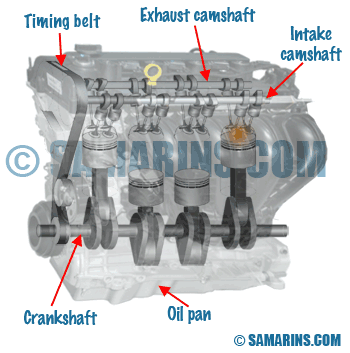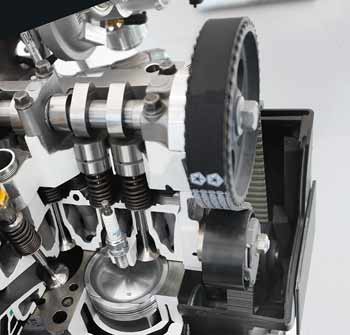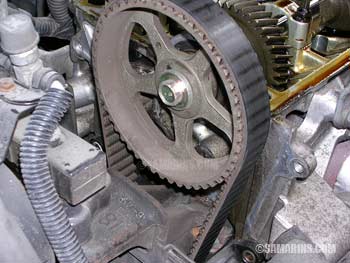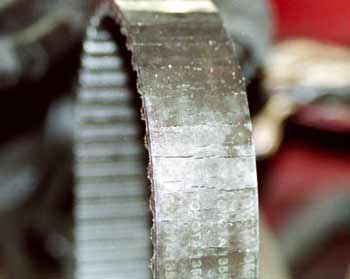Timing belt: problems, tensioner, what happens if it breaks, when to replace
Updated: January 05, 2019
The timing belt is a toothed belt that connects the engine crankshaft to the camshaft or camshafts as you can see in the picture.
 Timing belt in the 4-cylinder DOHC engine
Timing belt in the 4-cylinder DOHC engineIn some engines a timing belt can also drive additional components such as a water pump, balance shaft, intermediate shaft, injection pump and an oil pump. A balance shaft, an intermediate shaft and an injection pump must also be synchronised with a crankshaft.
To work properly a timing belt needs to be under certain tension that is controlled by a timing belt tensioner. Some older cars have an adjustable timing belt tensioner that must be re-adjusted if the timing belt gets loose. Newer cars have an automatic timing belt tensioner that doesn't need any adjustment. If the timing belt gets loose, it may skip a tooth and the proper timing will be lost.
When a timing belt is replaced, it's very important to set the timing properly. Before a new timing belt is installed, the crankshaft, the camshaft and other components synchronised with a crankshaft must be aligned in a certain way. A repair manual has proper instructions and a diagram with timing marks. Improperly set timing will cause a variety of problems such as lack of power, Check Engine light, vibration, misfiring, etc.
Timing belt or timing chain?
Not all cars have a timing belt - many newer cars use a timing chain instead of a belt. A timing belt wears out over time and needs to be replaced at a certain mileage. A timing chain can last as long as the engine itself and doesn't need to be replaced unless there is a problem with it.If you don't know if your vehicle has a timing belt or a chain, you can check your owner's manual. If you don't have an owner's manual, many car manufacturers offer to download it from their websites. You also can call your local dealer service department or ask your mechanic - they have this information. We also have this information for many cars in our used car reviews section.
When a timing belt must be replaced?
The timing belt must be replaced at recommended by the manufacturer intervals, usually from 60,000 miles to 105,000 miles (from 96,000 km to 168,000 km). Honda also specifies the time interval (every 84 months). You can find the recommended replacement interval in your owner's manual or in a separate maintenance booklet. In addition, the timing belt must be replaced if it has any damage like cracks (see the picture), cuts, or if it is soaked in oil leaking from the engine, or if it shows any signs of excessive wear.If not replaced in time, the timing belt can break. If you are approaching the mileage for a timing belt change, or if you bought a used car and you don't know if the timing belt has been replaced, it's a good idea to have your mechanic to inspect the timing belt condition. The timing belt is protected by timing belt covers. To inspect the timing belt condition, a mechanic might have to remove one of the covers.
What happens if the timing belt breaks?
If a timing belt breaks, the engine will no longer work. If a timing belt breaks while driving in an interference engine, the camshaft stops turning leaving some of the engine valves in the open position.Advertisement
The damage will be less extensive in a non-interference engine but in either case, the engine will stall, leaving you stranded.
You can check the "Timing Belts" section of Gates.com website to see if you have and an interference or non-interference engine.
Timing belt replacement cost
The cost to replace a timing belt may vary from about $200 to $750 depending on a model. Often your mechanic may recommend replacing a water pump or some other parts, such as, tensioner, seals idlers, etc. along with the timing belt; this obviously will cost more. You can just call your local dealer service department or a repair shop for an estimate.Q: How can I set the timing belt A: When the timing belt is replaced, the new belt must be set according to the timing marks so the camshaft(s) will be precisely timed with a crankshaft. Each vehicle has a way to align the timing belt with the camshaft(s) and the crankshaft. In some cars, the intermediate shaft or the balance shaft must also be aligned with a camshaft and the crankshaft. If you don't have the service manual, one way to set the timing is to mark the position of all sprockets with the old belt still installed and then use those marks to set the new belt properly. Of course it's best to use the service manual, as it has all the diagrams.



